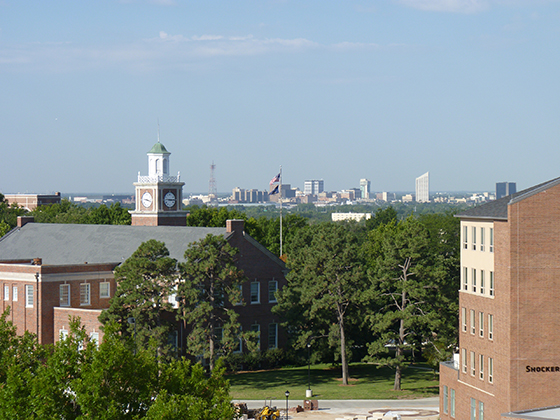Wichita State University is taking steps in improving safety on campus and in the surrounding neighborhoods.
These steps include efforts from the Enough is Enough Task Force, contributions from Westar Energy and increased security in the form of foot patrol officers.
“A healthy and happy community with good quality of life creates a stable environment,” says Ted Ayres, director of the Office of Community Engagement and Opportunity.
Ayres is involved in the Enough is Enough Task Force, a cooperative effort between the university, the city of Wichita and the Fairmount Neighborhood Association.
The Enough is Enough Task Force was formed in December 2014 in response to a brutal attack that occurred in Fairmount Park in November. The university’s participation is largely because of the correlation between a thriving community and a thriving campus.
“Our success and future are tied in every way to the success of the surrounding area,” said WSU President John Bardo at the announcement of the task force formation. “We know we have the expertise and capacity on this campus to help.”
The expertise comes into play through the Shocker Neighborhood Coalition, an organization made up of university faculty, staff and students. The coalition has seven focus areas: law enforcement, community relations, social issues, economic development, education, infrastructure and health and well-being. The purpose of these focus areas is to have a specialist in each department whom members of the community can contact with questions or concerns that fall under each respective category.
“There are a number of things the university can and should do to be a better neighbor,” Ayres says.
Student Awareness
While becoming a better neighbor to the surrounding community, WSU is also looking to be a good neighbor within its own boundaries. This is being achieved through lighting improvements and foot patrols of campus.
The lighting improvements, contributed by Westar Energy, are being made in several places on the streets that surround campus. These include lights on 17th Street, Hillside and 21st Street. Older light fixtures are being replaced and redirected toward campus to provide a well-lit environment around the university.
The increased lighting will help students be aware of their surroundings. Awareness is also the goal of the University Police Department, which has established regular foot patrols of campus.
Patrolman Chad Agnew walks the campus from 5 p.m.-1 a.m. Monday through Friday with his partner Jeff Albert. The pair were pulled off of their shifts in patrol cars to provide safety escorts and interact with students and faculty on campus.
“Students can approach us with questions and concerns,” Agnew says. “We want to build relationships with students and faculty.”
In their efforts to build these relationships, Agnew and Albert have been giving away prizes if students have the campus police number in their phone. These range from free drink coupons at Kwik-shop to 20 percent discounts at the University Bookstore. They have also started giving out card holders with the UPD phone number that stick to the back of phones.
Agnew also educates students about the importance of contacting university police instead of dialing 911 in case of emergency, as 911 calls will go to the Sedgwick County dispatch instead of staying on campus. Calling the university will allow them to respond more quickly and efficiently as they are familiar with the buildings and specific locations.
Though the two officers don’t have a specific route around campus, they try to make appearances at buildings when classes are letting out in the evening. Albert says they walk through Shocker Hall and Fairmount Towers at least twice a night and provide escorts as people make their way to their cars.
The officers have received a lot of positive feedback and thanks for what they are doing from students, faculty and members of the community.
“We’ve had people from the Fairmount neighborhood approach us and thank us,” Agnew says.
Agnew and Albert claim that they prefer walking the campus to driving it in the patrol car, mainly because of the vast difference in interaction. Albert says when they wave from the car, they won’t usually receive a response. When they’re walking across campus, however, students approach them and start conversations.
“They can talk about safety or they can talk about classes,” Agnew says. “We’re just trying to build that rapport and those relationships.”


 File
File